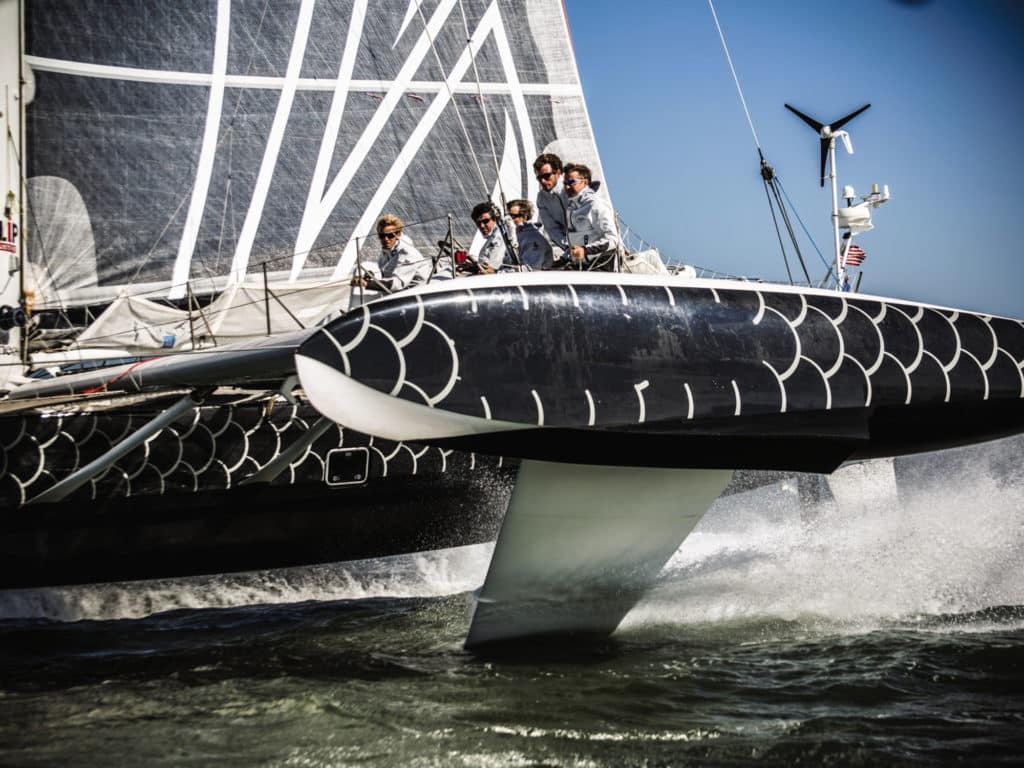
In the sport of sailing in 2021, foiling is all the rage and has completely revolutionized our game. Catamarans have been foiling in the America’s Cup for nearly a decade and have since spawned an entirely new breed of foiling monohull. Partially as a result of these unprecedented investments in foiling technology, the trickle-down has been rapid, widespread and eminently consequential. From the explosion of the foiling Moth dinghy and foiling beach cats and monohulls to the adaptation of hydrofoils on everything from surfboards and SUPs to Vendée Globe solo offshore rockets, kiteboards, and one-design racers—and even some cruising yachts—foiling has touched every aspect of yacht design. However, long before foiling went mainstream, there was one famous French foiling trimaran blazing its own bold path well above the ocean’s surface: l’Hydroptère.
The History
When the 60-foot l’Hydroptère was originally conceived in the 1970s, she more closely resembled a far-fetched futuristic concept of what a racing sailboat might one day look like than an actual boat. Compared with the heavy-displacement keelboats of the day, l’Hydroptère appeared to be something off the TV show The Jetsons. Conceived by the godfather of French offshore racing, Eric Tabarly, the initial concept of l’Hydroptère was simple. With wings riding under the water, the boat could achieve lift and then rise above its surface, thus greatly reducing the boat’s hydrodynamic drag while exponentially increasing its speed potential. Simply put, the idea was to marry sailing and flight; appropriately, l’Hydroptère’s name is a combination of the Greek word hydros, for water, and the French term, ptère, for wing.
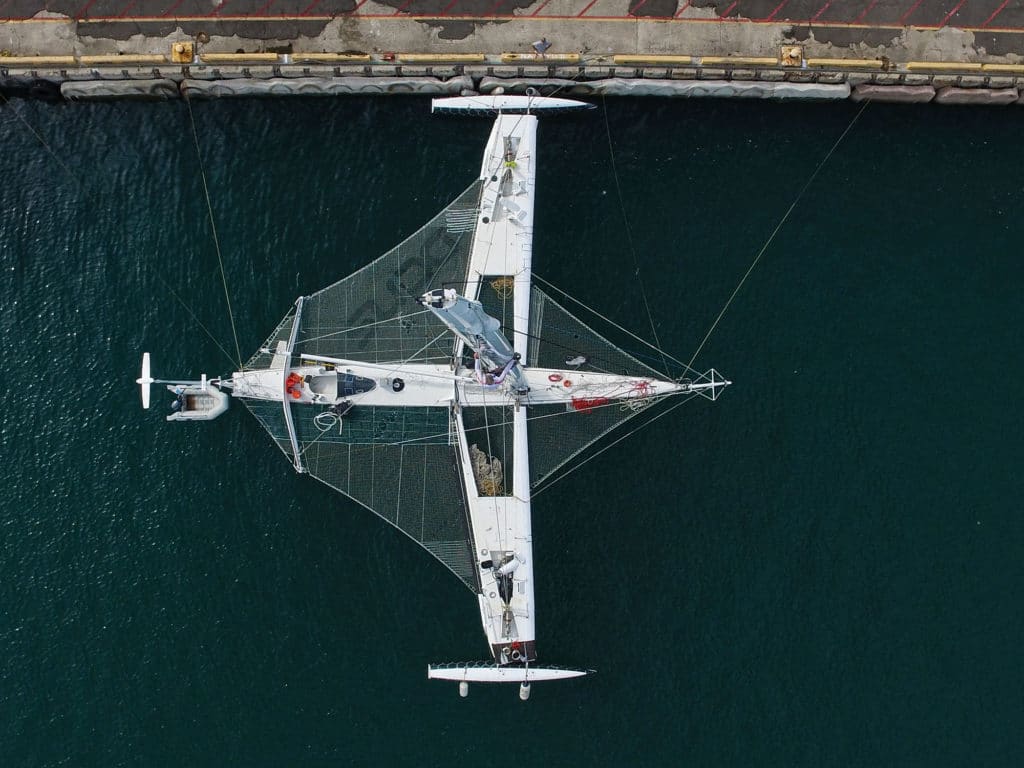
To pioneer the concept of a flying boat isn’t easy, and the many failures—and hard-earned victories—of l’Hydroptère are a testament to this fact. Working in conjunction with the now-dominant design firm VPLP and some of France’s top boatbuilders, project manager Alain Thébault, Tabarly and their collaborators worked through several evolutions of the basic l’Hydroptère concept before building the boat that would eventually crush world sailing speed records, inspire legions of sailors, and become the subject of sailing folklore.
After beginning with a simple wooden version of the concept in 1976 using a Tornado catamaran hull as the main central hull, by the mid-1980s, the team moved on to small, remote-controlled prototypes, followed by a one-man, one-third-scale flying boat by the early 1990s. In 1994, the dream literally took flight when a full-scale prototype was hovering well above the water off the coast of France. But in 1995, while sailing at close to 30 knots of boatspeed, l’Hydroptère suffered the structural failure of a port crossbeam and quickly crashed down to the water’s surface. Fortunately, the boat was salvaged and brought back to port.
Half a dozen years later, in 2001, the fourth and final iteration of l’Hydroptère was launched. Almost immediately after hitting the water, its increased speed potential was evident. In 2005, l’Hydroptère sailed across the English Channel at a sustained average speed of nearly 40 knots, eclipsing Louis Blériot’s first record for flying across the English Channel in an airplane in 1909. Two years later, in April 2007, l’Hydroptère sailed into the record books as the fastest sailboat over both 500 meters and 1 nautical mile, earning its first (but not last) World Sailing Speed Record.
To pioneer the concept of a flying boat isn’t easy, as the many early failures proved.
In December 2008, Thébault and his men peaked at more than 56 knots, briefly, before breaching l’Hydroptère’s foils and then immediately pitchpoling into a capsize. Undaunted, the team came back in 2009 stronger than ever and set another World Sailing Speed Record, this time covering 500 meters at an average speed of more than 51.3 knots of boatspeed with a peak of nearly 59 knots; it was an incredible achievement, and marked the first time a boat officially crossed the near-mythical 50-knot barrier for a sustained period of time. Coincidentally, this 50-knot barrier represents the current speed limit for the America’s Cup and Sail GP catamarans. Any faster, and foil ventilation and cavitation begins to rear its ugly head.
Highs and Lows
Entering a new decade in 2010, Thébault and his men secured another injection of funding for an entirely new adventure. With one World Sailing Speed Record firmly in hand, tri now aimed toward an infinitely larger racetrack: the Pacific Ocean. In May 2012, the boat arrived in the port of Long Beach, California, on a container ship to undergo further optimization before embarking on an ambitious record attempt to sail some 2,215 miles to Honolulu, Hawaii. With consistent trade winds and the long, groomed swells of the Pacific, the Transpac Race course was identified as the best potential venue to prove the concept of flying across an ocean—a goal that l’Hydroptère’s visionary, Tabarly, who had since passed away, had been pursuing since before the early 1980s when he sailed one of the world’s first ocean foilers, Paul Ricard, across the Atlantic and into the record books.
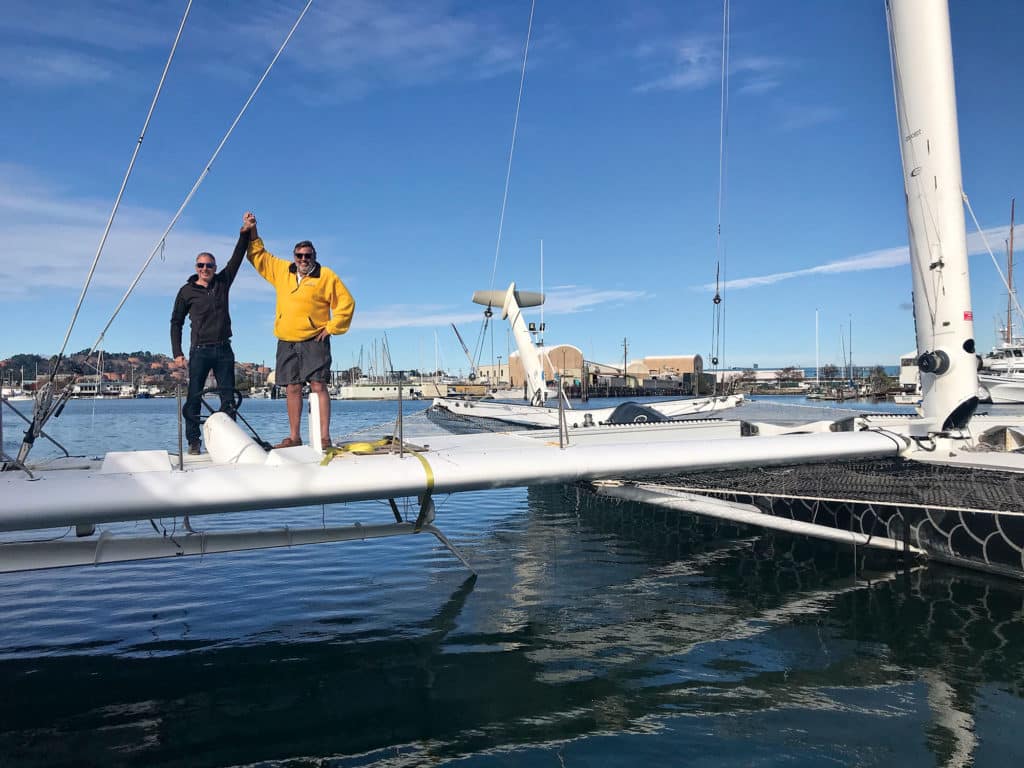
With a crew that included Vendée Globe legends Yves Parlier and Jean le Cam, as well as round-the-world multihull ace Jacques Vincent, l’Hydroptère was well-primed to fly to Hawaii in record time. Unfortunately, the 2012 record attempt was scrapped, and l’Hydroptère was instead moved to the San Francisco Bay area. On the hunt for sponsorship dollars there and in nearby Silicon Valley, l’Hydroptère began preparing for another assault on the Transpac course record the following year in 2013. The record, held by Frenchman Olivier de Kersauson and his crew on board the maxi-trimaran Geronimo, was set at just 4 days, 19 hours, 31 minutes, 37 seconds—certainly a very quick time to cover over 2,000 nautical miles, but it was well within the scope of a big, modern foiling trimaran.
However, the 2013 record attempt was also aborted. Perpetually strapped for cash and seemingly swimming against the tide in many respects, l’Hydroptère wouldn’t set sail for Hawaii until 2015. That year, with meager funds and their high-profile, rock-star sailors back in France, l’Hydroptère crossed the starting line with a crew of lesser-known, less-experienced sailors. Both the team and the weather window proved suboptimal. Attempting to run downwind in light air, this hydrofoiling reaching monster was relegated to drifting toward the islands at a relative snail’s pace, firmly stuck to the surface of the water. No foiling equals no fun. And certainly no speed record.
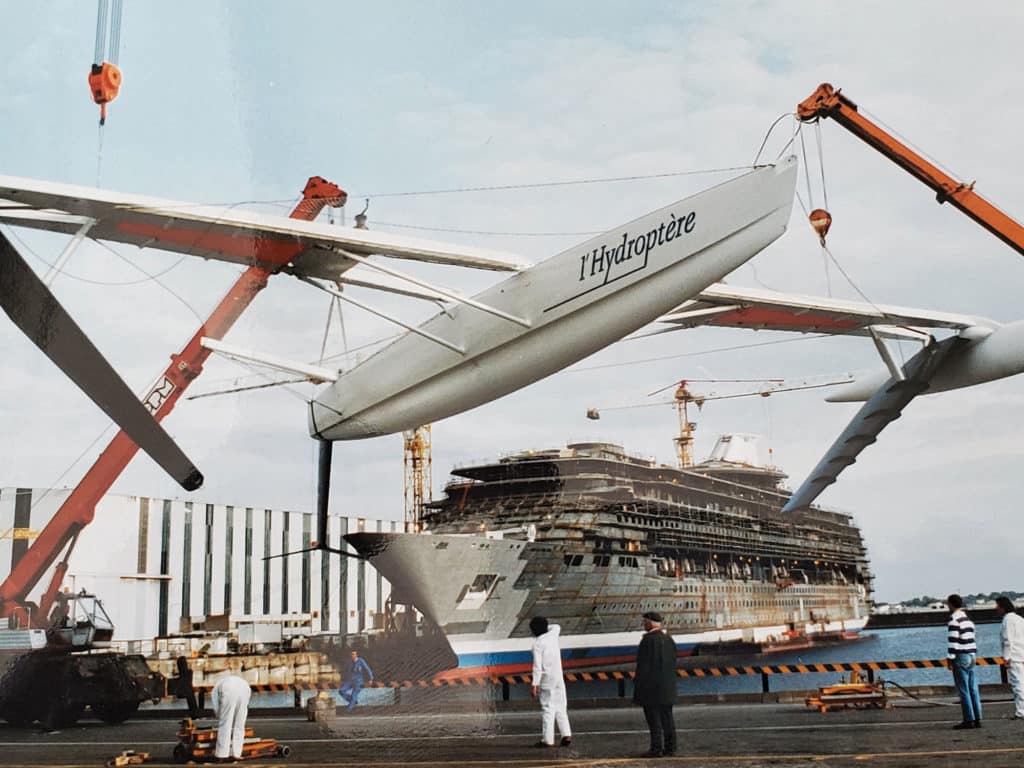
After an unsuccessful and embarrassingly slow Transpacific record attempt that took nearly 11 days—well over twice their goal—l’Hydroptère was left unceremoniously tied alongside a dock in Honolulu’s Kewalo Basin. The French program, already severely underfunded, eventually abandoned the tri in Hawaii. After a prolonged spell at Kewalo Basin, she was eventually moved to a state mooring ball in Keehi Lagoon. For most boats, this is akin to receiving a slowly implemented death sentence featuring no shortage of cruel and unusual punishment along the way.
Of all the seedy harbors in the state, perhaps no place is worse than the Keehi Lagoon mooring field. Located right beneath the flight path to the international airport, Keehi is loud, dusty, smelly and incessantly windy. Notorious for its derelict boats, floating meth labs and gross mismanagement, it’s a place where once-great boats go to die. Way in the back, just astern of the two submerged rigs of a sunken ketch, lay one of the fastest sailboats the world had ever seen, on its own downward spiral toward an ignominious death. To a passionate racing and cruising sailor like me, this was about as sad as it gets
No doubt about it, l’Hydroptère had hit rock bottom. Which meant there was only one way to go: up.
The Dream Renewed
For l’Hydroptère to be rescued and resurrected at this juncture, a savior was required. Luckily for the down-and-out vessel, not one but two such souls miraculously appeared.
“I had first seen l’Hydroptère several years earlier in Southern California while preparing for a Transpac race, and she certainly piqued my curiosity,” says Chris Welsh of Point Richmond, California. In June 2019, the abandoned l’Hydroptère went up for public auction, and Welsh was on an airplane to Honolulu to look her over more closely and place a bid on the boat. Owner of the Spencer 65 Ragtime—a veteran of more Transpacs than any other boat in history, and not coincidentally purchased from a police auction—Welsh had some history with massive multihulls as well. He owned Steve Fossett’s old maxi-catamaran Playstation, which had been converted to a powerboat named Cheyenne. Welsh clearly wasn’t afraid to take on an ambitious project with a famous and historic old boat. A prominent West Coast yachtsman who also owns Point Richmond’s commercial Sugar Dock marina, Welsh had both the resources and the vision to bring a boat like l’Hydroptère back to life.
But he wasn’t the only one.
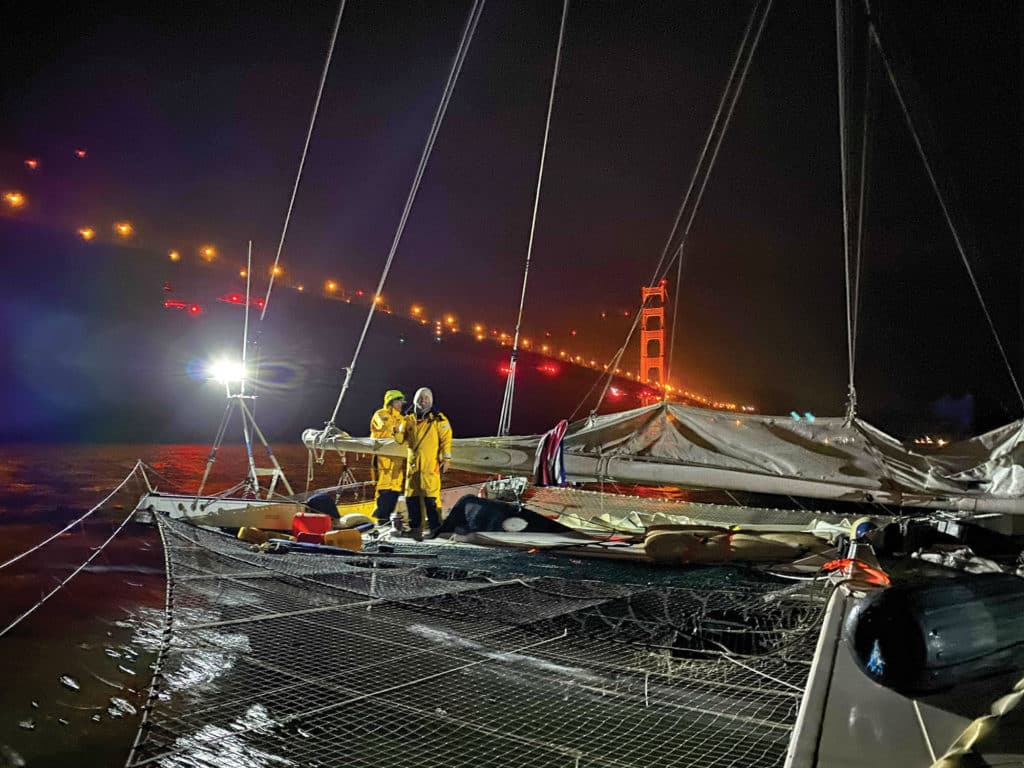
“It was always in my heart to follow this boat,” Frenchman Gabriel Terrasse says. “I had discovered l’Hydroptère at the Paris Boat Show in 1998, and then I went on the internet to learn more and I could not find anything, so I built a website about the boat. A few months later, the l’Hydroptère team had me build their official web page.” Fast-forward nearly two decades, and Gabriel’s interest in the boat had not dwindled. “In 2016, when the boat was first abandoned and for sale in Honolulu, I thought to buy her, but I was not quick enough. I knew l’Hydroptère had more inside her, more to accomplish, so when I heard that the boat was up for auction in 2019, I flew to Honolulu to buy her.”
The big tri was abandoned in a seedy harbor, on a sad, downward spiral toward death.
The two competing bidders met the night before the auction. “That is when I first met Gabriel,” Welsh says. “We were both there to buy l’Hydroptère. After talking, we shook hands and decided to team up.” This would prove to be the beginning of a very special, if unlikely, friendship. Welsh says, “With my yard in the Bay Area, it would just be so much easier and cheaper to refit the boat there, so we figured out what she needed to make the trip, hired a delivery captain, and then spent most of the summer getting the boat ready to sail back to San Francisco.”
A professional racing sailor on the West Coast, Hawaii and Asia, Mike Price was the delivery skipper tasked with getting l’Hydroptère back across the Pacific. “At its worst, l’Hydroptère was in very poor shape,” he recalls. “The coffee grinders had been stripped, the clutches and winches were removed, and the steering system, which was hydraulic, was ripped apart on one side but left intact on the other. Someone had bashed in the entry hatch and stolen the chart plotter, GPS and electronics. They left in place most of the hydraulics for the flight-control systems, but the sails and everything else were gone.”
A lesser sailor might’ve walked away, but even in her dilapidated condition, for Price, the sheer brilliance of l’Hydroptère shone through. “Structurally, the boat was very well-intact,” he says. “The hull was built a long time ago, and it was uncharacteristically overbuilt out of carbon. There were no breaks or cracks in the laminate or between structures. Being made completely out of carbon and titanium, everything seemed very solid. The mast and the standing rigging looked fine.”
Even so, before embarking on the trip to California, l’Hydroptère underwent a Honolulu refit that included a new diesel engine, some cobbled-together delivery sails, fresh deck hardware and winches, new backstays, and a lot of new lashings for the sail controls and rigging.
Then, Price says, “we brought a ton of diesel fuel, lashed it down everywhere we could find room, and left on the most benign weather window that presented itself. We had very flat seas and light air for the first 800 miles. We motored for six days at 5 to 6 knots, and it was nice for most of the passage. But it’s a very wet boat! At some point, every piece of electronics crapped out and had to be rewired at sea. The most wind that we ever saw was 25 knots, and we sailed the boat super conservatively with the foils all the way decambered to keep l’Hydroptère firmly in nonfoiling mode. We cruised under jib only when it was windy and made the passage in good shape. But it was something like science fiction, man. What a cool boat!”
Shortly after the boat returned to California, the COVID-19 pandemic brought much of the world to a halt, though this would prove to be a blessing in disguise for the newly reassembled l’Hydroptère team. “It was strangely good fortune that we ended up with five people all stuck together for 90 days,” Welsh says. “We got a lot done because we didn’t have a lot of distractions, so we just made the most of it. We cleaned up the boat and got everything out of it. It needed to be disassembled in a way that you could inventory the condition of things and restore them before putting it back together. In doing so, we were pleasantly surprised that the boat had survived the sun in Hawaii better than we expected.” Unfortunately, due to visa restrictions, Terrasse had to return to France, where he’s pursued new technical partners.
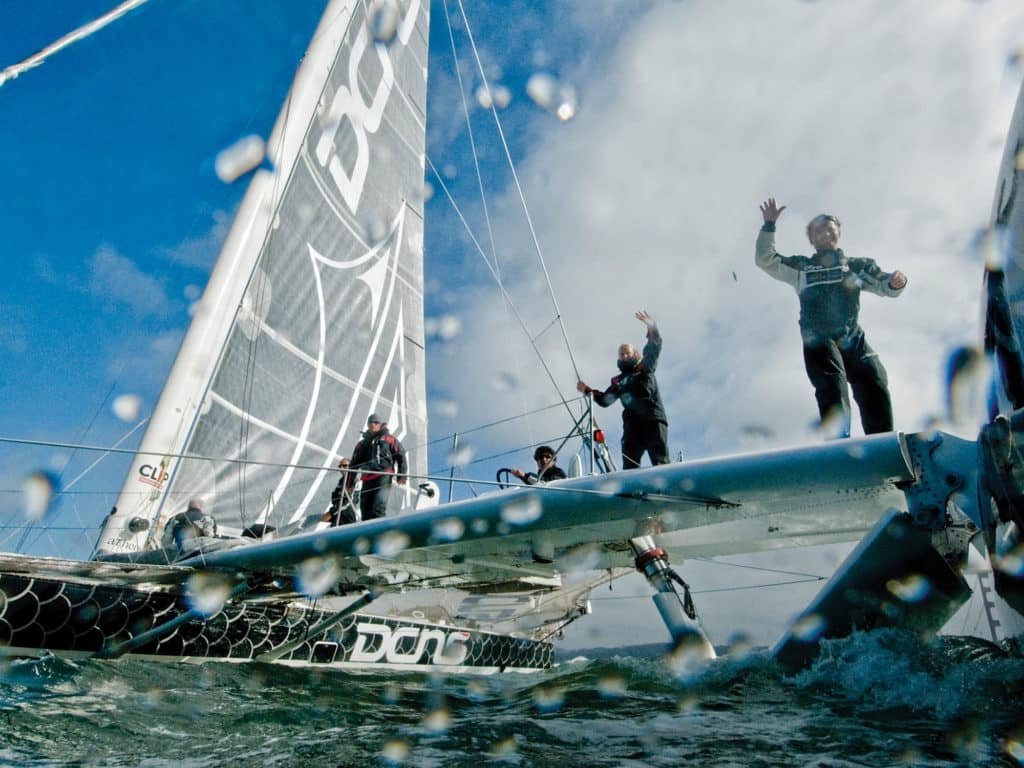
“L’Hydroptère is a big, tough boat,” Welsh says of the vessel he’s still learning about. “She is not some delicate wallflower that takes 25 guys to run. She was solidly constructed out of carbon and titanium, and is built for real sailing. She’s strong enough to try other foils, and there are some clear pathways to making her lighter. And l’Hydroptère is an interesting platform to move forward with, and there is still potential for some record breaking, particularly with point-to-point passages.”
Likewise, Terrasse insists that there is a lot more left in l’Hydroptère’s tank and that there remains a world of possibility. “We want to make her fly again,” he says. “To improve her. I’m working on the R&D to make her faster, with new technology. L’Hydroptère was built with 20-year-old technology. With rigid sails (a wing), with new foils for higher speeds, with more weight reduction…. There is a long list of possibilities. We have a big wish list. It is a nice and crazy project!”
Sailors are, by nature, dreamers. It’s one of the qualities that makes this sport so beautiful and keeps us all coming back. As well, the boats themselves, and the adventures that those vessels have inspired, have an uncanny ability to bring people together. From the forward-thinking sailors and engineers who first dreamed up this magnificent flying boat nearly 50 years ago to the unlikely cast of characters who are today bringing it back to life in Northern California and in France, l’Hydroptère has inspired legions of sailing fans for decades and continues to do so to this day. In a world in need of some good news right now, the unlikely renaissance of the world’s first famous flying boat—and the new bridges that have been built as a result—continue to remind us that anything is possible. What will l’Hydroptère’s next chapter bring? We don’t know. But we can’t wait to find out.
Offshore cruiser and racer Ronnie Simpson is a CW contributing editor.








